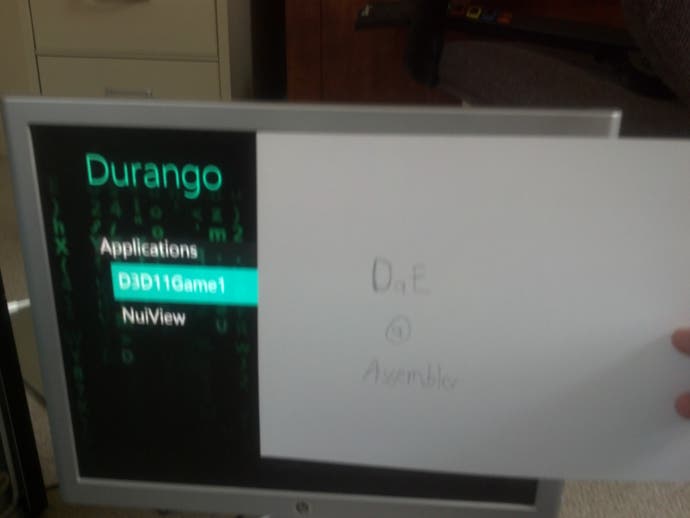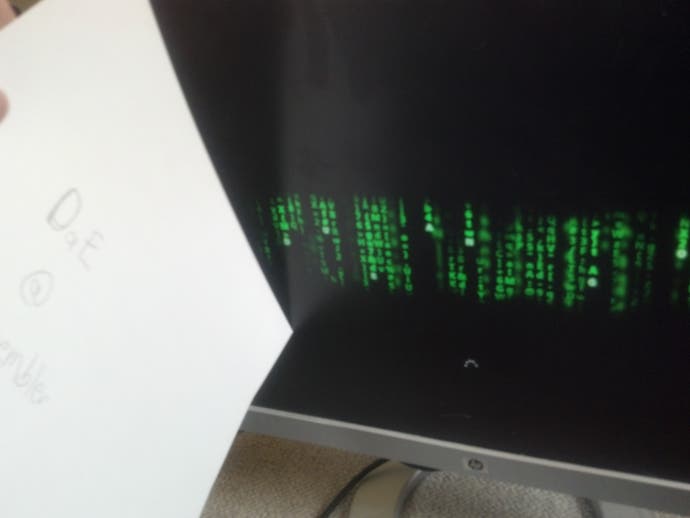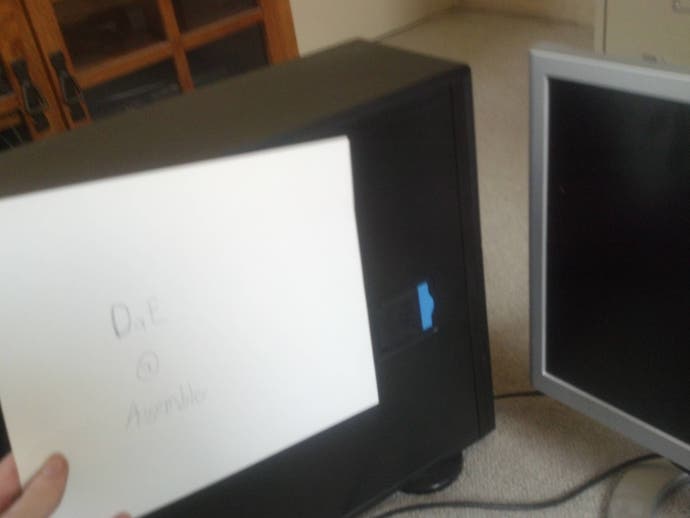The Curious Case of the Durango Devkit Leak
Shots of prototype next-gen Microsoft hardware "genuine" - Digital Foundry talks to the source.
It's one of the most bizarre next-gen console leaks yet - a story so strange we still struggle to believe there's any truth to it whatsoever. When a Microsoft Durango devkit appeared on an obscure developer forum - for sale at $10,000 no less - nobody quite knew for certain what on earth was going on. The shots depict an anonymous-looking PC tower case, attached to a cheap display and running Matrix-style datastream graphics over an unconvincing debug launcher. The obvious conclusion drawn by many was that it was an unambiguous fake. Intrigued, Digital Foundry reached out to the source of the leak, and followed up the story with multiple developers working on next-gen projects. The uniform response was startling: apparently, these shots are the real deal.
The devkit itself is an anonymous-looking black box, said by one next-gen developer to contain parts that have much in common with a modern "standard gaming PC". The shots depict a dashboard reminiscent of the current Xbox 360 test kit launcher, featuring a basic compiled program, dubbed "D3D11Game1" along with "NuiView" - which on 360 at least is a simple tool for rendering camera views and data from an attached Kinect peripheral. No next-gen Kinect hardware photos have yet to surface, but it is said to be considerably revised from the existing Xbox 360/PC peripheral.
We tracked down the man who leaked the initial shots, who uses the alias "DaE". At the time we spoke over instant messaging, he was seemingly running rampant across Europe, quaffing significant amounts of absinth. Being generous, his Twitter feed doesn't seem to make a lot of sense, and some of the claims being made about Halo 4 running on PowerPC/Xbox 360 emulators would stretch even Roger Moore's prodigious eyebrow-raising skills to absolute breaking point. However, the fact is that the pictures he leaked have been acknowledged as genuine by reliable sources we know to be working on AAA next-gen games, and the inescapable conclusion is that the leaker has indeed been hands-on with a Durango devkit - and then tried to sell it. DaE told us that this was a prank he played on the administrator of the AssemblerGames forum - the end result being that he was banned for his efforts and the offending post swiftly removed.
"Microsoft's next console is apparently 64-bit in nature and based heavily on Microsoft's DirectX 11 API, with current PC engines being easy to port across to the new console."




Beyond that, further information is sketchy and unreliable. DaE reckons that the current devkits were dispatched to studios in February, and feature Intel CPUs and a graphics card that carries the NVIDIA brand - but he doesn't identify either part more specifically. He also claims that the Durango kit features more than 8GB of memory (other sources have suggested 12GB), and that it is 64-bit in nature - at this point it's worth bearing in mind that dev hardware typically features double the RAM of retail kit in order to accommodate debugging tools and other systems. DaE also says that Microsoft is targeting an eight-core CPU for the final retail hardware - if true, this must surely be based around Atom architecture to fit inside the thermal envelope. The hardware configuration seems difficult to believe as it is so divorced from the technological make-up of the current Xbox 360, and we could find no corroborative sources to establish the Intel/NVIDIA hook-up, let alone the eight-core CPU.
However, another source, speaking in the wake of the Durango developer meet-up that took place in London just before GDC this year, corroborates that the system is 64-bit in nature, adding that current DirectX 11 engines developed on PC can be ported to 64-bit and that they will run with no problem on Microsoft's new console. The platform holder achieved immense success by basing the Xbox 360 workflow closely on existing PC development tools and the DirectX API and it looks as though it aims to continue that recipe for success with its next-gen offering.
In an effort to prove the authenticity of his devkit leak, DaE also leaked a screenshot of Microsoft's Visual Studio coding tool, apparently set-up for Durango. None of the developers we spoke to disputed what they were seeing. "As an aside it's got my favourite MS return code in there: ERROR_SUCCESS," chuckled one source.
The presence on this screen of the "immintrin" element strongly suggests that the Durango coding environment is built around x86 CPU architecture, supporting the AVX (advanced vector extensions) instruction set that was added in last year's Sandy Bridge revision. However, AVX is now supported on some of the most recent AMD processors too.
"As an aside it's got my favourite MS return code in there: ERROR_SUCCESS," chuckled one source.

Of course, this anonymous-looking PC box is not the machine Microsoft will be selling at retail next year - it's alpha kit, assembled from existing parts to best emulate the hardware configuration of the console and actual silicon will be in the closing phases of development as we speak. In a world where games typically take two years or more to develop, these units are lashed together to give game-makers a headstart in the absence of final hardware - Xbox 360 alpha kits were little more than PowerMacs with ATI graphics cards installed, and were still being used to demo code as late as E3 2005, mere months before the retail launch.
It's the mooted choice of hardware partners that is perhaps the most surprising element of this new twist in the Durango story, and the most crucial element that we could not double-source. Microsoft negotiated poor licensing deals with Intel and NVIDIA on the original Xbox that made the console uneconomical to produce in later years - thought to be one of the major reasons that the platform holder shifted to IBM for the 360's Xenon CPU and ATI (subsequently bought by AMD) for the Xenos graphics core. Unarguably, it is this graphics core that gave Microsoft its advantage over the PlayStation 3 in multi-platform games, and a shift back to NVIDIA would not only be surprising, but it would also outright contradict most of the rumours that have emerged about Durango to date.
At the very least, the x86 nature of the leaked Visual Studio shot is intriguing - in combination with the AMD rumours swirling around PlayStation 4, there's the very strong suggestion that the era of custom console hardware is now very much a thing of the past. Licensing revised versions of existing architecture - exactly as Sony did with PlayStation Vita - appears to be the most efficient way of getting the most powerful consoles without breaking the bank in terms of R&D. In a world where many blame consoles for the decline in PC gaming, it would be richly ironic if the next-gen platforms from Microsoft and Sony were based almost exclusively on PC technology...









